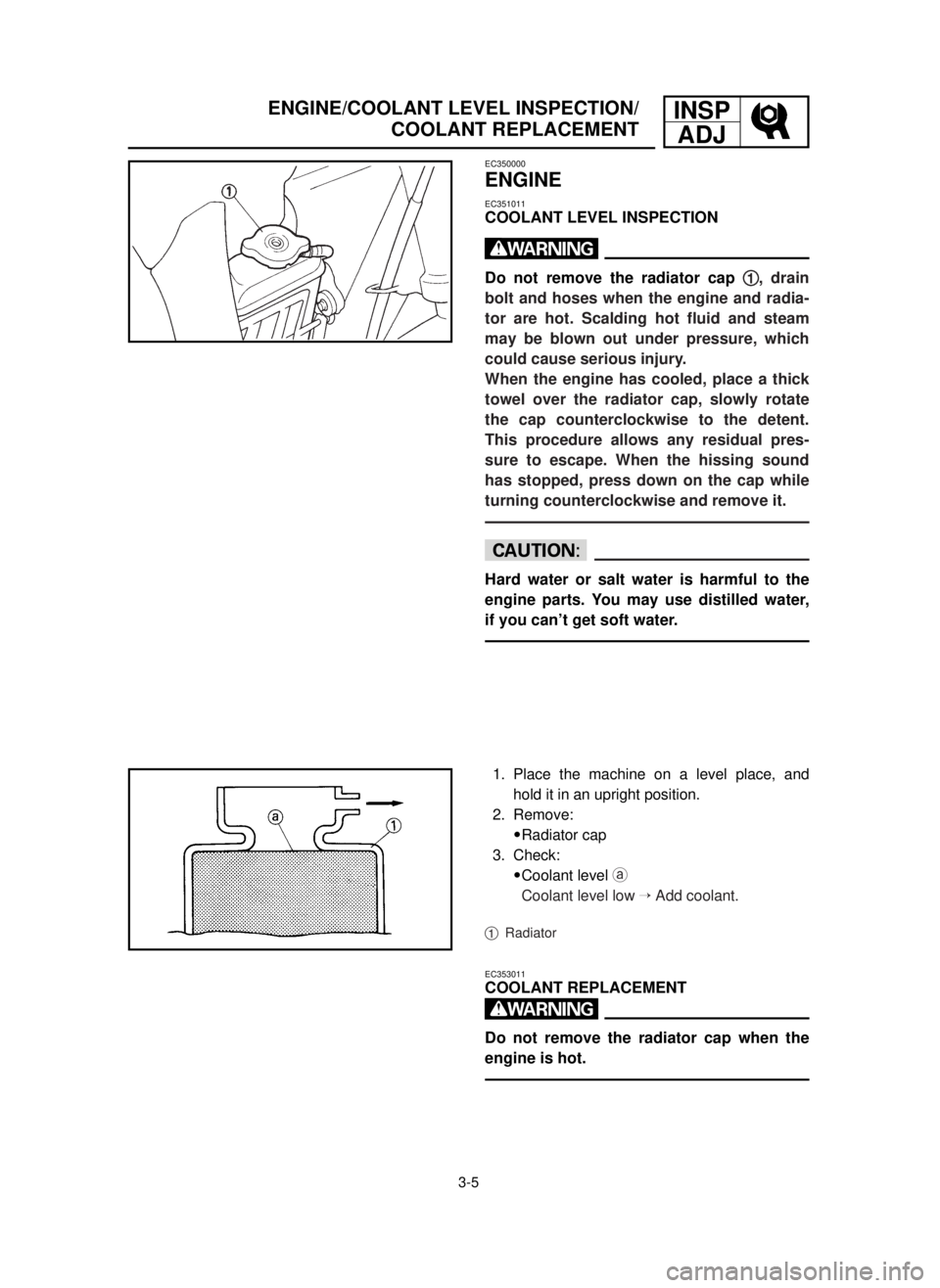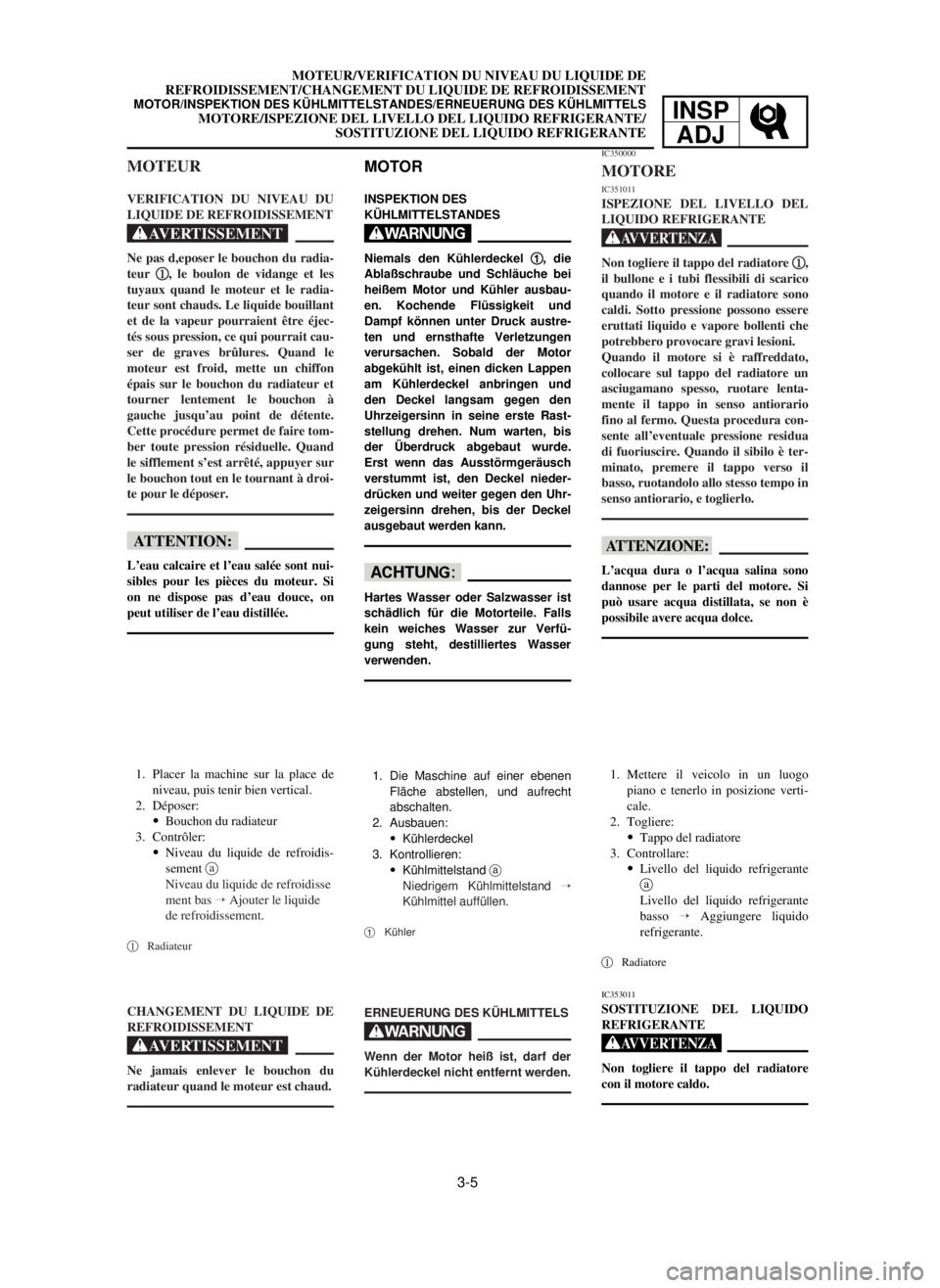YAMAHA YZ125LC 2001 Betriebsanleitungen (in German)
Manufacturer: YAMAHA, Model Year: 2001, Model line: YZ125LC, Model: YAMAHA YZ125LC 2001Pages: 558, PDF-Größe: 13.11 MB
Page 131 of 558

3-1
INTERVALLI DI MANUTENZIONE
INSP
ADJ
IC300000
REVISIONE E REGOLAZIONI REGOLARI
IC310051
INTERVALLI DI MANUTENZIONE
Il programma che segue vuole essere una guida generale alla manutenzione e alla lubrificazione. Tenere
presente che fattori quali le condizioni atmosferiche, il terreno, la posizione geografica e l’uso individuale
modificheranno gli intervalli di manutenzione e di lubrificazione necessari. Se si hanno dubbi sugli interval-
li da seguire per la manutenzione e la lubrificazione del veicolo, consultare il concessionario Yamaha.
Dopo il Ogni OgniIn base
Voce
rodaggiogaraOgni
cinquealle Osservazioninecessità
PISTONE
Ispezione e pulitura
66
Sostituzione66
FASCIA ELASTICA
Ispezione
66
Sostituzione66
SPINOTTO, CUSCINETTO A
ESTREMITÀ PICCOLA
Ispezione
6
Sostituzione6
TESTA CILINDRO
Ispezione e pulitura
66
Riserraggio66
CILINDRO
Ispezione e pulitura
66
6
Sostituzione
YPVS
Ispezione e pulitura
66
FRIZIONE
Ispezione e regolazione
66
Sostituzione6
TRASMISSIONE
Sostituzione dell’olio
66
Ispezione6
Sostituzione del cuscinetto6
FORCELLA DEL CAMBIO,
CAMMA DEL CAMBIO,
GUIDA DI SCORRIMENTO
Ispezione
6
DADO DEL ROTORE
Riserraggio
66
MARMITTA
Ispezione
66
Pulitura6
GOMITO
Ispezione e pulitura
66
CARBURATORE
Ispezione, regolazione e pulitura
66
CANDELA
Ispezione e pulitura
66
Sostituzione6
CATENA DI TRASMISSIONE
Lubrificazione, gioco, allineamento
66
Sostituzione6
Ispezionare incrinatura
Togliere carbonio
Controllare distanza
dell’estremità della fascia
Togliere carbonio
Controllare guarnizione
Ispezionare segni di rigature
Ispezionare usura
Ispezionare coperchio, disco
della frizione, disco di inne-
sto e molla
Olio per motori Yamalube 4
(10W-30) o SAE 10W-30 SE
Ispezionare usura
Usare lubrificante per catene
Gioco della catena: 40~50 mm
(1,6 ~ 2,0 in)
5MV-9-30-3A 6/19/00 1:52 PM Page 11
Page 132 of 558

3-2
INTERVALLI DI MANUTENZIONE
INSP
ADJ
IMPIANTO DI RAFFREDDAMENTO
Controllo livello e perdite di liquido
66refrigerante
Controllo funzionamento del tappo
del radiatore
6
Sostituzione del liquido refrigerante6
Ispezione dei tubi flessibili6
DADI E VITI ESTERNI
Riserraggio
66
FILTRO DELL’ARIA
Pulitura e lubrificazione
66
Sostituzione6
TELAIO
Pulitura e ispezione
66
SERBATOIO, RUBINETTO DEL
CARBURANTE
Pulitura e ispezione
66
FRENI
Regolazione posizione della leva e
66altezza del pedale
Lubrificazione punto di snodo
66
Controllo superficie del disco del freno66
Controllo livello e perdite di liquido66
Riserraggio bulloni del disco del
freno, bulloni della pinza, bulloni del
66
cilindro principale e bulloni di unione
Sostituzione pastiglie
6
Sostituzione liquido per freni6
FORCELLE ANTERIORI
Ispezione e regolazione
66
Sostituzione dell’olio66
Sostituzione del paraolio6
PARAOLIO E PARAPOLVERE
DELLA FORCELLA ANTERIORE
Pulitura e lubrificazione
66
AMMORTIZZATORE POSTERIORE
Ispezione e regolazione
66
Lubrificazione 66
Riserraggio66
COPRICATENA E RULLI PER
CATENA
Ispezione
66
FORCELLONE OSCILLANTE
Ispezione e riserraggio
66
BRACCIO DI RINVIO, LEVA
DI RINVIO
Ispezione e lubrificazione
66
TESTA DI STERZO
Ispezione gioco libero e riserraggio
66
Pulitura e lubrificazione6
Sostituzione del cuscinetto6
Ogni due anni
Consultare la sezione
“AVVIAMENTO E
RODAGGIO” al CAPITOLO 1.
Usare olio per filtri dell’aria
in schiuma
Ogni anno
Olio per sospensioni “01”
Grasso a base di litio
Grasso a base di bisolfuro di
molibdeno
Grasso a base di bisolfuro di
molibdeno
Grasso a base di litio Dopo il Ogni OgniIn base
Voce
rodaggiogaraOgni
cinquealle Osservazioninecessità
5MV-9-30-3A 6/19/00 1:52 PM Page 12
Page 133 of 558

3-3
INTERVALLI DI MANUTENZIONE
INSP
ADJ
Dopo il Ogni OgniIn base
Voce
rodaggiogaraOgni
cinquealle Osservazioninecessità
Grasso a base di litio
Lubrificante per cavi
Yamaha oppure olio per
motori SAE 10W-30 PNEUMATICO, RUOTE
Ispezione della pressione dell’aria,
dellascentratura della ruota,
66dell’usura dello pneumatico e
dell’allentamento delle razze
Riserraggio bullone del rocchetto
66
Ispezione dei cuscinetti6
Sostituzione dei cuscinetti6
Lubrificazione6
VALVOLA A FARFALLA, CAVO
DI COMANDO
Controllo dell’instradamento e del
66collegamento
Lubrificazione
66
5MV-9-30-3A 6/19/00 1:52 PM Page 13
Page 134 of 558

3-4
PRE-OPERATION INSPECTION AND MAINTENANCE
INSP
ADJ
EC320000
PRE-OPERATION INSPECTION AND MAINTENANCE
Before riding for break-in operation, practice or a race, make sure the machine is in good operating
condition.
Before using this machine, check the following points.
EC321000
GENERAL INSPECTION AND MAINTENANCE
Item Routine Page
Coolant Check that coolant is filled up to the radiator filler cap.
Check the cooling system for leakage.P3-5~9
Fuel Check that a fresh mixture of oil and gasoline is filled in
the fuel tank. Check the fuel line for leakage.P1-12
Transmission oil Check that the oil level is correct. Check the crankcase
for leakage.P3-12~14
Gear shifter and clutch Check that gears can be shifted correctly in order and
that the clutch operates smoothly.P3-9
Throttle grip/Housing Check that the throttle grip operation and free play
are correctly adjusted. Lubricate the throttle grip and P3-10~11
housing, if necessary.
Brakes Check the play of front brake and effect of front and
rear brake.P3-17~23
Chain Check chain slack and alignment. Check that the chain
is lubricated properly.P3-24~26
Wheels Check for excessive wear and tire pressure. Check for
loose spokes and have no excessive play.P3-34~35
Steering Check that the handlebar can be turned smoothly and
have no excessive play.P3-35~36
Front forks and Check that they operate smoothly and there is no oil
rear shock absorber leakage.P3-26~33
Cables (wires) Check that the clutch and throttle cables move smooth-
ly. Check that they are not caught when the handlebars —
are turned or when the front forks travel up and down.
Muffler Check that the muffler is tightly mounted and has no
cracks.P3-15~16
Sprocket Check that the driven sprocket tightening bolt is
not loose.P3-24
Lubrication Check for smooth operation. Lubricate if necessary. P3-37
Bolts and nuts Check the chassis and engine for loose bolts and nuts. P1-16
Lead connectors Check that the CDI magneto, CDI unit, and ignition coil
are connected tightly.P1-6
Settings Is the machine set suitably for the condition of the
racing course and weather or by taking into account the
P7-1~24
results of test runs before racing? Are inspection and
maintenance completely done?
5MV-9-30-3A 6/19/00 1:52 PM Page 14
Page 135 of 558

3-4
INSPECTION ET ENTRETIEN AVANT UTILISATION
INSP
ADJ
INSPECTION ET ENTRETIEN AVANT UTILISATION
Avant la conduite pour le rodage, l’entraînement ou une course, s’assurer que la machine est en bou état de
marche.
Avant d’utiliser cette machine, contrôler les points suivants:
INSPECTION GENERALE ET ENTRETIEN
Partie Routine Page
Eau de Refroidissement S’assurer qu’il y a du liquide de refroidissement
jusqu’au bouchon de l’orifice de remplissage du radi-
P3-5~9
ateur. S’assurer que le circuit de refroidissement ne
fuient pas.
Carburant S’assurer qu’un mélange d’huile et d’essence frais est
dans le réservoir à carburant. S’assurer que la canalisa- P1-12
tion de carburant ne fuient pas.
Huile de transmission S’assurer que le niveau d’huile de transmission est cor-
rect. S’assurer que le carter ne fuient pas.P3-12~14
Sélecteur et embrayage S’assurer que les vitesses peuvent être sélectionnées cor-
rectement et dans l’ordre et que l’embrayage foncionne P3-9
en douceur.
Poignée des gaz/boîtier S’assurer que la poignée des gaz fonctionne bien et que
le jeu est correct. Lubrifier au besoin la poignée et le car- P3-10~11
ter.
Freins Contrôler le jeu de frein avant et l’efficacité des freins
avant et arrière.P3-17~23
Chaîne Contrôler la tension et l’alignement de la chaîne. S’as-
surer que la chaîne est graissée correctement.P3-24~26
Roues Contrôler s’il n’y a pas d’usure excessive. Contrôler s’il
n’y a pas de rayons détendus et qu’il n’a pas de jeu ex- P3-34~35
cessif.
Direction S’assurer que le guidon peut être tourné en douceur et
qu’il n’a pas de jeu excessif.P3-35~36
Fourche avant et S’assurer qu’ils fonctionnent en douceur et qu’il n’y a
amortisseur arrière pas de fuite d’huile.P3-26~33
Câbles S’assurer que les câbles d’embrayage, de frein et d’ac-
célération coulissent librement. S’assurer qu’ils ne sont
—
pas coincés quand le guidon est tourné ou quand la
fourche avant est comprimée puis détendue.
Pot d’echappement S’assurer que le pot d’échappement est bien fixé et qu’il
n’est pas fendu.P3-15~16
Roue dentée S’assurer que le boulon de fixation de la roue dentée
entraînée n’est pas desserré.P3-24
Graissage Contrôler si le fonctionnement se fait en douceur./
Lubrifier si nécessaire.P3-37
Boulons et ecrous S’assurer que les boulons et écrous de la partie cycle et
du moteur ne sont pas desserrés.P1-16
Connecteurs S’assurer que la magnéto CDI, le bloc CDI et la bobine
P1-6
d’allumage sont bien branchés.
Réglages La machine est-elle réglée convenablement pour la con-
dition du parcours de la course et du temps, ou en tenant
P7-1~24
compte des marches d’essai avant la course? Contrôle et
entretien sont-ils faits en totalité?
5MV-9-30-3A 6/19/00 1:52 PM Page 15
Page 136 of 558

3-4
PRÜFUNG UND WARTUNG VOR DER INBETRIEBNAHME
INSP
ADJ
PRÜFUNG UND WARTUNG VOR DER INBETRIEBNAHME
Vor dem Einfahren, einer Übungs-oder Rennfahrt, immer die Maschine auf guten Betriebszustand
kontrollieren.
Vor der Benutzung dieser Maschine sind die folgenden Punkte zu prüfen:
ALLGEMEINE PRÜFUNG UND WARTUNG
Benennung Vorgang Seite
Kühlmittel Darauf achten, daß Kühlmittel bis zum Kühler-Einfüll-
stutzen aufgefüllt ist. Die Kühlanlage auf Undichtigkeit P3-5~9
untersuchen.
Kraftstoff Sicherstellen, daß der Kraftstofftank mit einem frischen
Gemisch aus Benzin und Öl gefüllt ist. Die Kraftstofflinie P1-12
auf Undichtigkeit untersuchen.
Getriebeöl Auf richtigen Getriebeölstand achten. Das kurbelgehäu-
se auf Undichtigkeit untersuchen.P3-12~14
Schaltung und Kupplung Sicherstellen, daß die Kupplung richtig funktioniert und
alle Gänge problemlos eingelegt werden können.P3-9
Gasdrehgriff/ Darauf achten, daß der Gasdrehgriff richtig funktioniert
Lagergehäuse und das Spiel richtig eingestellt ist. Gasdrehgriff und P3-10~11
Gehäuse schmieren, wenn erforderlich.
BremsenDie Vorderradbremse auf Spiel und die Vorder-und Hin-
terradbremse auf zufriedenstellende Bremswirkung prüfen.P3-17~23
Kette Die Kette auf richtige Spannung und Ausrichtung prü-
fen. Auch sicherstellen, daß die Kette richtig geschmiert P3-24~26
ist.
Räder Die Reifen auf übermäßige Abnutzung kontrollieren.
Speichern auf Lockerung und übermäßiges Spiel prü- P3-34~35
fen.
Lenkung Darauf achten, daß sich die Lenkstange glatt drehen
läßt und kein übermäßiges Spiel aufweist.P3-35~36
Vorderradgabel und Auf richtige Funktion achten und sicherstellen, daß kein
Hinterrad-Stoßdämpfer Ölaustritt vorliegt.P3-26~33
Seilzüge Kupplungs-, Brems- und Gasseile auf glatte Bewegung
prüfen. Auch darauf achten, daß diese nicht behindert
werden, wenn die Lenkstange gedreht bzw. die Vorderrad-—
gabel zusammengedrückt und wieder freigelassen wird.
Schalldämpfer Daraf achten, daß der Schalldämpfer richtig montiert
ist und keine Risse aufweist.P3-15~16
Kettenrad Sicherstellen, daß die Befestigungsschraube des
Abtriebskettenrades richtig festgezogen ist.P3-24
Schmierung Funktion prüfen. Wenn erforderlich schmieren. P3-37
Schrauben und Muttern Das Fahrgestell und den Motor auf lose Schrauben und
Muttern kontrollieren.P1-16
Kabelstecker Sicherstellen, daß der CDI-Schwungmagnetzünder, die
CDI-Einheit und die Zündspule richtig angeschlossen P1-6
sind.
Einstellung Immer darauf achten, daß die Maschine für die her-
rschenden Bedingungen, die Rennstrecke und die Wet-
ternbedingungen richtig eingestellt ist, wobei die im P7-1~24
Probelauf erzielten Ergebnisse zu berücksichtigen sind?
Auch auf richtige Inspektion und Wartung achten?
5MV-9-30-3A 6/19/00 1:52 PM Page 16
Page 137 of 558

3-4
ISPEZIONE E MANUTENZIONE PRIMA DEL
INSP
ADJ
Voce Procedura Pagina
Controllare che il liquido refrigerante sia riempito fino al
tappo di riempimento del radiatore.Controllare
l’impianto di raffreddamento per eventuali perdite.
Controllare che il serbatoio del carburante sia riempito
con una miscela fresca di olio e benzina. Controllare il
tubo del carborante per eventuali perdite.
Controllare che il livello dell’olio sia corretto.
Controllare il carter per eventuali perdite.
Controllare che sia possibile cambiare correttamente le
marce in ordine e che la frizione funzioni senza strappi.
Controllare che il funzionamento e il gioco libero della
manopola dell’acceleratore siano regolati correî.
Lubrificare la manopola dell’acceleratore e la carcassa,
se necessario.
Controllare il gioco del freno anteriore e l’effetto del
freno anteriore e posteriore.
Controllare il gioco e l’allineamento della catena.
Controllare che la catena sia lubrificata adeguatamente.
Controllare l’usura eccessiva e la pressione degli
pneumatici. Controllare che le razze non siano allentate e
non abbiano un gioco eccessivo.
Controllare che il manubrio possa essere girato senza
strappi e non abbia un gioco eccessivo.
Controllare che funzionino senza problemi e che non vi
siano perdite d’olio.
Controllare che i cavi della frizione e dell’acceleratore si
muovano senza problemi. Controllare che non rimanga-
no impigliati quando viene girato il manubrio o quando
le forcelle anteriori si alzano e si abbassano.
Controllare che la marmitta sia montata saldamente e
non presenti incrinature.
Controllare che il bullone di serraggio del rocchetto
condotto non sia allentato.
Controllare il regolare funzionamento. Lubrificare se
necessario.
Controllare il telaio e il motore per eventuali viti e dadi
allentati.
Controllare che il magnete CDI, l’unità CDI e la bobina
di accensione siano collegati saldamente.
Il veicolo è impostato correttamente per le condizioni del
circuito di gara e atmosferiche o tenendo conto dei
risultati delle prove prima della gara? L’ispezione e la
manutenzione sono state effettuate in maniera completa?
Liquido refrigerante
Carburante
Olio per trasmissioni
Cambio e frizione
Manopola dell’acceleratore/
Carcassa
Freni
Catena
Ruote
Sterzo
Forcelle anteriori e
ammortizzatore posteriore
Cavi (fili)
Marmitta
Rocchetto
Lubrificazione
Viti e dadi
Connettori dei conduttori
ImpostazioniP3-5~9
P1-12
P3-12~14
P3-9
P3-10~11
P3-17~23
P3-24~26
P3-34~35
P3-35~36
P3-26~33
—
P3-15~16
P3-24
P3-37
P1-16
P1-6
P7-1~24
IC320000
ISPEZIONE E MANUTENZIONE PRIMA DEL FUNZIONAMENTO
Prima di usarlo per il rodaggio, per allenamento o per una gara, accertarsi che il veicolo sia in buone condi-
zioni di funzionamento.
Prima di usare questo veicolo, controllare i punti che seguono.
IC321000
ISPEZIONE E MANUTENZIONE GENERALI
5MV-9-30-3A 6/19/00 1:52 PM Page 17
Page 138 of 558

3-5
INSP
ADJENGINE/COOLANT LEVEL INSPECTION/
COOLANT REPLACEMENT
EC350000
ENGINE
EC351011
COOLANT LEVEL INSPECTION
w
Do not remove the radiator cap 1 1
, drain
bolt and hoses when the engine and radia-
tor are hot. Scalding hot fluid and steam
may be blown out under pressure, which
could cause serious injury.
When the engine has cooled, place a thick
towel over the radiator cap, slowly rotate
the cap counterclockwise to the detent.
This procedure allows any residual pres-
sure to escape. When the hissing sound
has stopped, press down on the cap while
turning counterclockwise and remove it.
cC
Hard water or salt water is harmful to the
engine parts. You may use distilled water,
if you can’t get soft water.
1. Place the machine on a level place, and
hold it in an upright position.
2. Remove:
9Radiator cap
3. Check:
9Coolant level a
Coolant level low ÕAdd coolant.
1Radiator
EC353011
COOLANT REPLACEMENT
w
Do not remove the radiator cap when the
engine is hot.
5MV-9-30-3A 6/19/00 1:52 PM Page 18
Page 139 of 558

3-5
MOTEUR/VERIFICATION DU NIVEAU DU LIQUIDE DE
REFROIDISSEMENT/CHANGEMENT DU LIQUIDE DE REFROIDISSEMENT
MOTOR/INSPEKTION DES KÜHLMITTELSTANDES/ERNEUERUNG DES KÜHLMITTELSMOTORE/ISPEZIONE DEL LIVELLO DEL LIQUIDO REFRIGERANTE/
SOSTITUZIONE DEL LIQUIDO REFRIGERANTEINSP
ADJ
MOTOR
INSPEKTION DES
KÜHLMITTELSTANDES
W
Niemals den Kühlerdeckel 1 1
, die
Ablaßschraube und Schläuche bei
heißem Motor und Kühler ausbau-
en. Kochende Flüssigkeit und
Dampf können unter Druck austre-
ten und ernsthafte Verletzungen
verursachen. Sobald der Motor
abgekühlt ist, einen dicken Lappen
am Kühlerdeckel anbringen und
den Deckel langsam gegen den
Uhrzeigersinn in seine erste Rast-
stellung drehen. Num warten, bis
der Überdruck abgebaut wurde.
Erst wenn das Ausstörmgeräusch
verstummt ist, den Deckel nieder-
drücken und weiter gegen den Uhr-
zeigersinn drehen, bis der Deckel
ausgebaut werden kann.
dD
Hartes Wasser oder Salzwasser ist
schädlich für die Motorteile. Falls
kein weiches Wasser zur Verfü-
gung steht, destilliertes Wasser
verwenden.
1. Die Maschine auf einer ebenen
Fläche abstellen, und aufrecht
abschalten.
2. Ausbauen:
9Kühlerdeckel
3. Kontrollieren:
9Kühlmittelstand a
Niedrigem Kühlmittelstand Õ
Kühlmittel auffüllen.
1Kühler
ERNEUERUNG DES KÜHLMITTELS
W
Wenn der Motor heiß ist, darf der
Kühlerdeckel nicht entfernt werden.
MOTEUR
VERIFICATION DU NIVEAU DU
LIQUIDE DE REFROIDISSEMENT
XG
Ne pas d,eposer le bouchon du radia-
teur 1 1
, le boulon de vidange et les
tuyaux quand le moteur et le radia-
teur sont chauds. Le liquide bouillant
et de la vapeur pourraient être éjec-
tés sous pression, ce qui pourrait cau-
ser de graves brûlures. Quand le
moteur est froid, mette un chiffon
épais sur le bouchon du radiateur et
tourner lentement le bouchon à
gauche jusqu’au point de détente.
Cette procédure permet de faire tom-
ber toute pression résiduelle. Quand
le sifflement s’est arrêté, appuyer sur
le bouchon tout en le tournant à droi-
te pour le déposer.
fF
L’eau calcaire et l’eau salée sont nui-
sibles pour les pièces du moteur. Si
on ne dispose pas d’eau douce, on
peut utiliser de l’eau distillée.
1. Placer la machine sur la place de
niveau, puis tenir bien vertical.
2. Déposer:
9Bouchon du radiateur
3. Contrôler:
9Niveau du liquide de refroidis-
sement a
Niveau du liquide de refroidisse
ment bas Õ Ajouter le liquide
de refroidissement.
1Radiateur
CHANGEMENT DU LIQUIDE DE
REFROIDISSEMENT
XG
Ne jamais enlever le bouchon du
radiateur quand le moteur est chaud.
IC350000
MOTORE
IC351011
ISPEZIONE DEL LIVELLO DEL
LIQUIDO REFRIGERANTE
T
Non togliere il tappo del radiatore 1 1
,
il bullone e i tubi flessibili di scarico
quando il motore e il radiatore sono
caldi. Sotto pressione possono essere
eruttati liquido e vapore bollenti che
potrebbero provocare gravi lesioni.
Quando il motore si è raffreddato,
collocare sul tappo del radiatore un
asciugamano spesso, ruotare lenta-
mente il tappo in senso antiorario
fino al fermo. Questa procedura con-
sente all’eventuale pressione residua
di fuoriuscire. Quando il sibilo è ter-
minato, premere il tappo verso il
basso, ruotandolo allo stesso tempo in
senso antiorario, e toglierlo.
iI
L’acqua dura o l’acqua salina sono
dannose per le parti del motore. Si
può usare acqua distillata, se non è
possibile avere acqua dolce.
1. Mettere il veicolo in un luogo
piano e tenerlo in posizione verti-
cale.
2. Togliere:
9Tappo del radiatore
3. Controllare:
9Livello del liquido refrigerante
a
Livello del liquido refrigerante
basso ÕAggiungere liquido
refrigerante.
1Radiatore
IC353011
SOSTITUZIONE DEL LIQUIDO
REFRIGERANTE
T
Non togliere il tappo del radiatore
con il motore caldo.
5MV-9-30-3A 6/19/00 1:52 PM Page 19
Page 140 of 558

3-6
INSP
ADJ
COOLANT REPLACEMENT
cC
Take care so that coolant does not splash
on painted surfaces. If it splashes, wash it
away with water.
1. Place a container under the engine.
2. Remove:
9Coolant drain bolt 1
3. Remove:
9Radiator cap
Drain the coolant completely.
4. Clean:
9Cooling system
Thoroughly flush the cooling system with
clean tap water.
5. Install:
9Copper washer
9Coolant drain bolt
6. Fill:
9Radiator
9Engine
To specified level.
Recommended coolant:
High quality ethylene glycol
anti-freeze containing
anti-corrosion for
aluminum engine
Coolant 1 1
and water
(soft water) 2 2
mixing ratio:
50%/50%
Coolant capacity:
1.00 L (0.88 Imp qt, 1.06 US qt)
10 Nm (1.0 m•kg, 7.2 ft•lb)
5MV-9-30-3A 6/19/00 1:52 PM Page 20